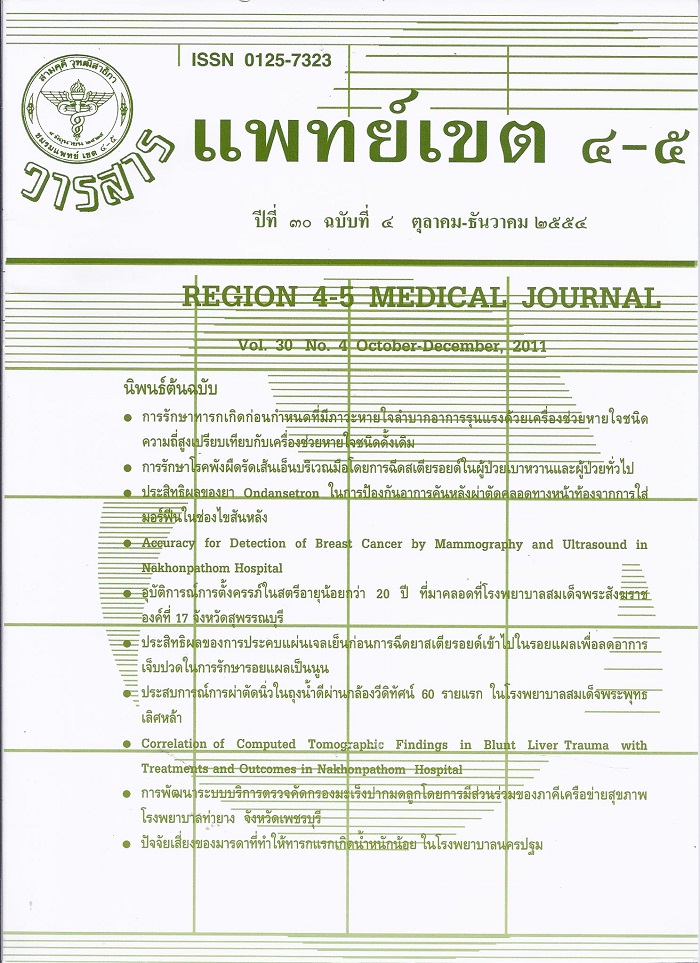การรักษาทารกเกิดก่อนกำหนดที่มีภาวะหายใจลำบากอาการรุนแรง ด้วยเครื่องช่วยหายใจชนิดความถี่สูง เปรียบเทียบกับเครื่องช่วยหายใจชนิดดั้งเดิม
คำสำคัญ:
ทารกเกิดก่อนกำหนด, ภาวะหายใจลำบาก, เครื่องช่วยหายใจชนิดความถี่สูง, ภาวะแทรกซ้อนบทคัดย่อ
Introduction: Respiratory distress syndrome is common and is an important cause of mortality among preterm infants. Mechanical ventilation is essential in treating these infants with frequent complications.
Objective: To study the results and complications of treatment of severe respiratory distress syndrome in preterm infants with high-frequency oscillatory ventilation (HFO) compared with conventional ventilation (CV).
Method: A retrospective descriptive study was conducted in preterm infants with severe respiratory distress syndrome in NICU at Phrachomklao hospital, Phetchaburi, Thailand. There were 2 groups of infants: one was treated with HFO, another with CV. Complications from ventilation and treatment were compared as well as days on ventilators, days on oxygen therapy, days after oxygen therapy, weight gain, length of stay, expense and mortality.
Results: During January 2009-April 2011, 16 preterm infants with severe respiratory distress syndrome were treated with HFO and 24 with CV. There was no difference in capillary blood gases taken at 1, 6, 12 and 24 hours after ventilation in these 2 groups of infants. Complications from ventilation (pneumothorax, pulmonary hemorrhage, atelectasis, ventilator-associated pneumonia (VAP), slipping and obstruction of endotracheal tube) and comorbidities/complications from treatment were not different. Outcomes of treatment: average day on ventilators was 7.25 and 10.21 (p = 0.295), average day on oxygen therapy were 25.44 and 19.88 (p = 0.539), average days after oxygen therapy were 1.13 and 5.71 (p = 0.001), average weight gain was 870 and 540 gm (p = 0.101), average length of stay was 36.06 and 35.88 days (p = 0.986), average expense was 147,522 and 149,295 baht (p = 0.966) and mortality was 9/16 (56.3%) and 7/24 (29.2%) (p = 0.110) in infants with HFO and CV, respectively.
Conclusions: HFO and CV seemed equally effective in preterm infants with severe respiratory distress syndrome. Complications from ventilation and comorbidities/complications from treatment were not different; however, there were tendencies of lower incidence of VAP and the slipping of endotracheal tube in the HFO group.
Downloads
เผยแพร่แล้ว
How to Cite
ฉบับ
บท
License
ลิขสิทธิ์บทความเป็นของผู้เขียนบทความ แต่หากผลงานของท่านได้รับการพิจารณาตีพิมพ์ลงวารสารแพทย์เขต 4-5 จะคงไว้ซึ่งสิทธิ์ในการตีพิมพ์ครั้งแรกด้วยเหตุที่บทความจะปรากฎในวารสารที่เข้าถึงได้ จึงอนุญาตให้นำบทความในวารสารไปใช้ประโยชน์ได้ในเชิงวิชาการโดยจำเป็นต้องมีการอ้างอิงถึงชื่อวารสารอย่างถูกต้อง แต่ไม่อนุญาตให้นำไปใช้ในเชิงพาณิชย์



